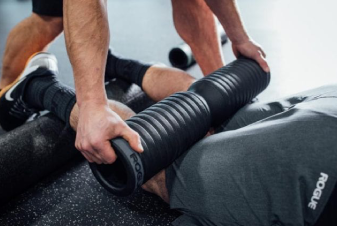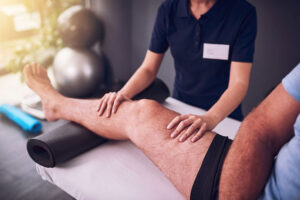Body tempering has become one of the most talked-about techniques in the fitness world, particularly for muscle recovery. Created by renowned powerlifter Donnie Thompson, this innovative recovery method involves rolling weighted cylinders over muscles and joints. It’s quickly gained traction among athletes, bodybuilders, and fitness enthusiasts who are looking for an effective way to boost recovery and improve their performance.
Unlike traditional methods like static stretching or manual massage, body tempering offers a deeper, more lasting effect on the soft tissues. Whether you’re a seasoned athlete or just starting your fitness journey, body tempering can be a game-changer for enhancing flexibility, reducing soreness, and improving recovery time.
How Body Tempering Works
At the core of body tempering is the use of weighted cylinders that are rolled over muscles and joints. These devices typically range in weight from 20 lbs to 200 lbs, with a design that ensures pressure is distributed evenly across the targeted area. The rolling action helps to mobilize soft tissue by breaking up adhesions, releasing muscle tension, and improving blood flow.
The process targets both large muscle groups and deeper soft tissues, such as fascia and connective tissues. This allows the muscles to be prepared for activity while also promoting quicker recovery post-workout. Unlike static stretching, which primarily focuses on elongating muscles, body tempering works to actively mobilize tissues, increasing joint range of motion and flexibility over time.
Benefits of Body Tempering
There are numerous benefits of body tempering, making it an appealing choice for muscle recovery and performance enhancement. Some of the key advantages include:
Enhances Flexibility & Mobility
Regular use of body tempering can help increase joint mobility and flexibility. By targeting deep layers of muscle and connective tissue, it encourages better range of motion, which can improve movement quality and performance.
Boosts Recovery
Compared to traditional muscle recovery methods like stretching or manual massage, body tempering has been shown to deliver longer-lasting effects. It helps clear out lactic acid, decrease muscle stiffness, and improve overall recovery time, making it ideal for athletes and anyone pushing their body to its limits.
Relieves Muscle Tension
If you experience tight muscles or chronic muscle soreness, body tempering may offer relief. By using the weighted cylinders, you apply steady pressure to tight muscle areas, which can alleviate discomfort and reduce overall muscle tension.
Improves Performance
Body tempering isn’t just a recovery tool—it’s also a performance-enhancing technique. Preparing muscles and joints before intense physical activity can help you perform better during workouts or competitions. By enhancing blood flow and tissue elasticity, it can help prevent injuries and boost your physical capabilities.
Why Body Tempering is Better than Other Recovery Techniques
When comparing body tempering vs massage or body tempering vs stretching, body tempering has distinct advantages. Here’s why:
- Massage: While manual massage can alleviate muscle tension, it typically doesn’t target the deeper layers of soft tissue. Body tempering, on the other hand, applies pressure across a larger surface area, allowing for more comprehensive mobilization of tissues.
- Stretching: Static stretching primarily works on elongating the muscles, which is essential for flexibility. However, it doesn’t focus on breaking down adhesions or promoting deep muscle recovery like body tempering does. Tempering targets both surface and deep tissue layers, which means longer-lasting benefits.
Body tempering is ideal for anyone looking for a technique that goes beyond the basics of recovery and addresses both muscle preparation and muscle repair.
How to Use Body Tempering Safely and Effectively
Using body tempering devices can be highly effective if done correctly. However, to ensure you get the most out of the technique and avoid injuries, here are some tips:
- Start Slowly: If you’re new to body tempering, begin with a lighter cylinder (20-40 lbs) and gradually work your way up to heavier weights.
- Use Proper Technique: Ensure that you are applying even pressure across the muscle group. Focus on areas with more tension but avoid excessive pressure that could cause discomfort or injury.
- Consult a Professional: It’s highly recommended to seek guidance from a physical therapist or a fitness professional if you’re unsure about how to incorporate body tempering into your routine. They can help you get the most effective and safe results.
Who Should Use Body Tempering?
Body tempering is suitable for a wide range of individuals, especially:
- Athletes: Bodybuilders, powerlifters, runners, and other athletes who push their bodies to extremes can greatly benefit from the muscle recovery and performance-boosting properties of body tempering.
- Fitness Enthusiasts: If you’re someone who exercises regularly, body tempering can help alleviate soreness, improve your range of motion, and accelerate recovery.
- Anyone with Chronic Muscle Tightness: Individuals dealing with muscle tension, tightness, or soreness can find significant relief with body tempering, especially when traditional methods aren’t enough.
Body Tempering Devices: Choosing the Right One
The tempering cylinders used for body tempering come in various sizes and weights. When choosing the right device, consider your goals and fitness level:
- Beginner: Start with a lighter cylinder (20-40 lbs) to get the feel of the technique.
- Intermediate/Advanced: As your body adapts, you can move to heavier cylinders (60-200 lbs) for deeper tissue mobilization.
Always ensure that the tempering device you choose is high quality, durable, and designed to distribute pressure evenly across the muscle group.
Common Mistakes to Avoid When Using Body Tempering
To get the most out of body tempering and avoid injury, keep these common mistakes in mind:
- Using Too Much Weight Too Soon: Start with lighter weights and gradually progress to avoid overwhelming your muscles.
- Applying Uneven Pressure: Ensure you’re rolling the cylinder evenly across the muscle. Uneven pressure can cause injury or unnecessary strain on certain areas.
- Not Listening to Your Body: Always pay attention to how your body feels. If something doesn’t feel right, stop and consult a professional.
Takeaway
Incorporating body tempering into your recovery routine can have significant benefits for your performance, flexibility, and overall muscle health. Whether you’re an athlete pushing for peak performance or someone who experiences chronic muscle tightness, body tempering offers a unique solution for addressing muscle recovery needs.






